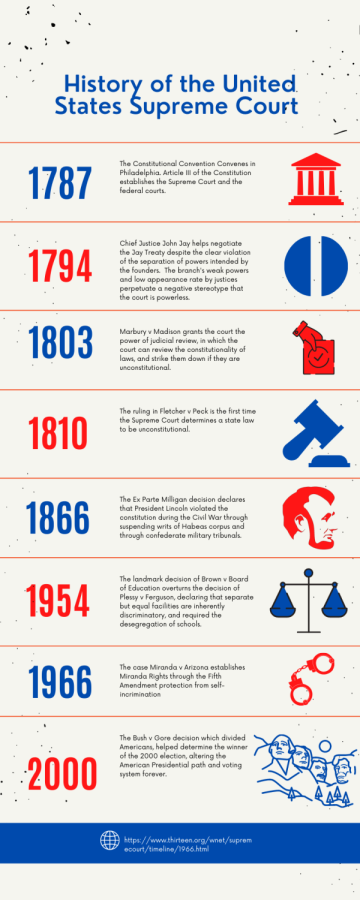How the Supreme Court reflects Trump’s presidency
The history of the Supreme Court contains many controversies and decisions that even impacted modern-day politics and society.
February 9, 2022
While Congress may be the most controversial branch and the executive the most publicized branch, the Supreme Court quietly and decisively guides and controls the legal system of our nation. The founding fathers intended for this branch to be the weakest – yet its impact on our everyday lives is massive.
Currently, the Supreme Court features three justices appointed by Former President Donald Trump: Justice Kavanaugh, Justice Gorsuch, and Justice Coney-Barrett. All three of these nominations came under fire for two main reasons: the Republican blockade against Merrick Garland and the fact that an impeached president was able to make a lifetime appointment to a crucial aspect of American politics.
The 2016 debacle
After the death of Antonia Scalia, a conservative Justice, Former President Obama quickly recommended the chief judge of the U.S. Court of Appeals for the District of Columbia Circuit, Merrick Garland to fill the vacancy. To sum up, the disaster that occurred after this, partisan gridlock, and a republican stronghold of the senate judiciary committee blocked the appointment left the seat vacant for 293 days — and opened the door for Trump to push his nominees through.
“Trump’s influence on the court is still seen today, and honestly it’s more than it should be since the tactics used to block Merrick Garland were mostly used to ensure Trump could nominate justices,” says Yash Totale (‘22).
Former President Trump was impeached twice and nominated Amy Coney Barrett to fill Former Justice Ginsburg’s vacancy after his first impeachment.
“Because of these nominations, Former President Trump was able to shift and secure the Majority for the conservative block,” says Akash Madiraju (‘22)
Majority Rules
Since the Supreme court leans strongly right, many of the recent decisions of the current court have been unrepresentative of the American public. Despite the American people electing a democratic President, House, and Senate, Supreme Court rulings have reflected former President Trump’s conservative values.
“The American Populace voted for Democratic Candidates, so as of right now, the Supreme Court is unrepresentative of the people. This was worsened due to Trump’s 3 nominations,” says Terrance Moore (‘23)
The Decision in Americans for Prosperity v Bonta, in which the majority ruled that the California Attorney General violated charity donors’ freedom of speech reflects a pattern of valuing individual rights over the common good, something Justices throughout history have had to grapple with.
But one of the most alarming decisions made by the Supreme Court is in Brnovich v. Democratic National Committee. Here, the majority upheld discriminatory voting laws in Arizona and challenged the security measures of the Voting Rights Act. Historically, limiting voting rights has been detrimental to minority voter turnout, perhaps these decisions could be a repeat of history.
“With this decision, the People of Arizona have to suffer through voting restrictions due to a one-term presidency. His impact can be seen even on the state level which is alarming” says Leah Allari (‘22).
Justice Breyer’s retirement announcement leaves many Americans fearing a repeat of 2016, as things look grim for congressional democrats. Realistically, Biden has nine months with a secured Democratic Majority in both houses. If he wants to leave a legacy and maintain the makeup of the court, he must act fast.
“At this point, I feel like the only way for the court to become more democratic is for the current administration to pack the court,” says Emma Baer (‘23).





